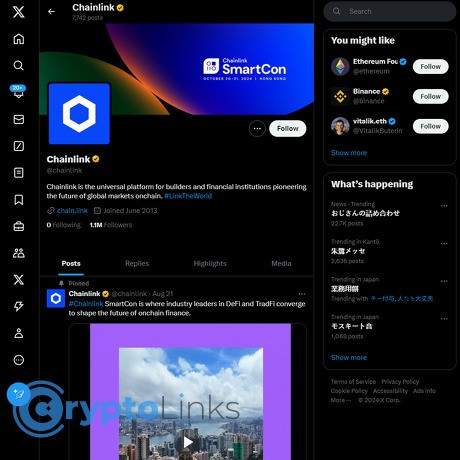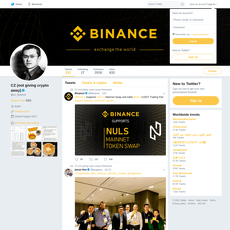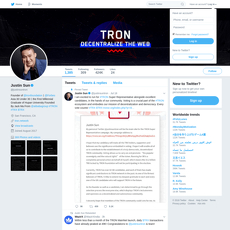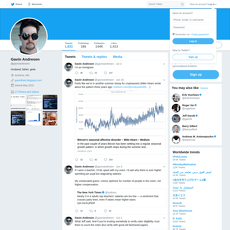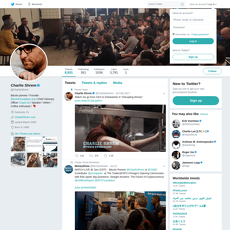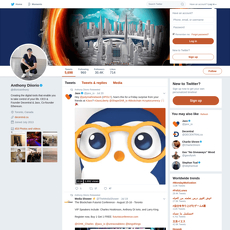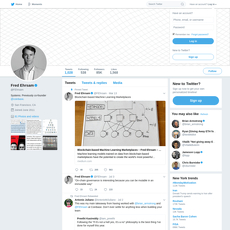Chainlink Review
Chainlink
x.com
Chainlink (LINK) review guide: everything you need to know + FAQ
Ever wondered how a smart contract “knows” the price of ETH, picks a random winner in an NFT mint, or sends a message to another chain without breaking trust?
If you’ve touched DeFi, NFTs, or cross‑chain apps, there’s a good chance you’ve already used Chainlink—whether you noticed or not. In this guide, I’m going to cut through the noise and give you the straight story on what Chainlink is, how it really works, where it’s strong, where it stumbles, and the answers people actually need.
If you just want the official firehose for updates, here’s the official Chainlink X account. If you want clear context and practical takeaways, keep reading.
The problems people hit with Chainlink
Chainlink sits between on-chain code and the outside world. That makes it powerful—and easy to misunderstand. These are the roadblocks I see over and over:
- Name confusion: Search “chainlink” and you’ll get hardware stores and rust-proofing tips. Chain link fences are not Chainlink oracles. Totally different worlds.
- Oracle risk feels fuzzy: People hear “oracles” and think “trust issues.” The real questions are sharper: How accurate are price feeds? What happens during a market spike? Who guarantees uptime? If a feed posts a bad price, lending markets can liquidate users fast—this risk is well documented across DeFi risk reports (see firms like Gauntlet discussing oracle sensitivity and liquidation cascades).
- Tokenomics questions never end: What is LINK actually used for? Do protocols pay in LINK or dollars? Where does staking fit? Who gets rewards, and who takes slashing risk? Most articles gloss over the billing and incentive details that matter.
- Big headlines vs. real delivery: You’ll see splashy mentions of banks and market infrastructure. Some are legit pilots—like industry tests involving names such as SWIFT (for multi-chain access) and DTCC (standardizing data flows)—but it’s easy to overread a pilot as “full production.”
- Price predictions without context: Endless charts, no discussion of usage, revenue, or security trade-offs. That’s entertainment, not research.
My promise: simple answers, practical takeaways
Here’s the deal: I’ll keep it plain, link to sources where it helps, and separate what’s live from what’s experimental. No hype, no doomposting—just what you can actually use.
- Clear language: I’ll explain the tech and incentives without insider jargon. When I say “oracle network,” you’ll know exactly what that means and why it exists.
- What’s real today: We’ll call out what’s running in production (like price feeds and verifiable randomness used by top protocols) vs. what’s still being rolled out.
- Actual trade-offs: I’ll talk through centralization concerns, node operator concentration, data-provider curation, and competition—because those shape real risk.
- Quick wins: You’ll get practical tips on how to research usage, track feed health, and avoid common mistakes—whether you’re a user, builder, or just curious.
What you’ll get from this guide
If you only have a few minutes, you’ll still walk away with a working model of Chainlink—what it is, how it’s used, and why people trust it (or don’t). Here’s what’s ahead:
- A fast definition of Chainlink and its core products: Data Feeds, VRF (verifiable randomness), Automation, Proof of Reserve, and CCIP for cross-chain messaging.
- How the network is secured and paid: who runs nodes, how data gets aggregated, where LINK and staking fit, and what “enterprise billing” actually means.
- Where enterprises and banks show up: how industry pilots (think SWIFT and DTCC) map to real use cases versus marketing slides.
- Pros, cons, and myths: what Chainlink does well, where it struggles, and how teams handle oracle redundancy with other providers.
- FAQs you actually care about: the honest answers to “downsides,” “will banks use it,” and “do I need LINK,” with pointers so you can verify claims yourself.
Ready for a one‑page snapshot of what Chainlink is and why it matters—without the fluff? Let’s keep going.
Chainlink in one page: what it is and why it matters
If smart contracts are the “autopilot,” Chainlink is the instrument panel feeding them the weather, the speed, and the runway lights. It’s a decentralized oracle network that delivers off-chain data and secure cross-chain messages to on-chain apps, so your DeFi trade, NFT mint, or cross-chain transfer can react to the real world without trusting a single company.
Why does this matter? Because most blockchains can’t talk to web APIs or other chains by themselves. Chainlink stepped into that gap and became the default data layer for a lot of DeFi. Reliability, battle-tested infrastructure, and consistent pricing updates are what protocols care about when a bad data point can liquidate users or drain treasuries.
“Trust is earned in seconds and lost in a single bad price update.”
Here’s the short version of what Chainlink is, what it ships, where it stands against competitors, and how it’s used in production today.
Quick definition: oracle network for data and messaging
An oracle is a service that brings external data to blockchains and sends messages between them. Chainlink coordinates independent node operators and multiple data sources to produce aggregated, tamper-resistant answers that smart contracts can rely on. It’s chain-agnostic: you’ll find Chainlink feeds and services across Ethereum, Arbitrum, Optimism, Polygon, BNB Chain, Avalanche, and more.
At a high level, Chainlink’s model is “many reputable nodes pull from many reputable sources, agree off-chain, then post a single update on-chain.” That balance keeps costs reasonable while prioritizing liveness and data quality.
Core products at a glance
Data Feeds (prices, indices)
Aggregated, high-availability price feeds for assets and indices used by lending, derivatives, and stablecoins. Updates are triggered by deviation and heartbeat thresholds to balance cost with freshness.
Learn more: docs.chain.link/data-feeds
VRF (Verifiable Random Function)
Cryptographically provable randomness for games, lotteries, and trait reveals. Contracts get a random number plus a proof that anyone can verify on-chain, eliminating “rigged” draws.
Learn more: docs.chain.link/vrf
Automation (Keepers)
A decentralized way to call smart contract functions on a schedule or when conditions are met—no centralized server or cron job required. Useful for rebalancing, reward distribution, liquidations, and upkeep.
Learn more: docs.chain.link/automation
Proof of Reserve
On-chain checks that a token’s reserves actually exist (e.g., bridged assets or fiat-backed tokens). Contracts can pause or reject actions if reserves don’t match supply.
Learn more: docs.chain.link/proof-of-reserve
CCIP (Cross-Chain Interoperability Protocol)
Secure messaging and token transfers across chains with an explicit focus on risk separation and defense-in-depth. Built for applications that need to communicate across ecosystems without DIY bridge risk.
Learn more: docs.chain.link/ccip
How it stacks up against alternatives
Pyth Network — Focuses on low-latency market data sourced directly from exchanges and market makers, with a pull-based “on-demand” model on many chains. Strong fit for perps and high-frequency strategies that tolerate faster updates with different trust assumptions.
Site: pyth.network
Band Protocol — Uses a Cosmos-based chain (BandChain) to collect data and post it to destination chains. Emphasizes cross-chain support and a single oracle network coordinating updates.
Site: bandprotocol.com
API3 — “First-party oracles” where data providers run Airnodes and serve data directly, aiming to reduce middlemen. Projects use dAPIs fed by those providers.
Site: api3.org
UMA — An optimistic oracle that assumes data is correct unless challenged. Great for cases where “truth” is subjective or requires human input (insurance, KPI options, long-tail data).
Site: uma.xyz
Why do teams often use more than one? Because oracle risk is real. Multiple oracles, exchange TWAPs, or circuit breakers reduce correlated failures. If one feed stalls or spikes, a failover or sanity check can save a protocol from cascading liquidations.
Real examples you’ll recognize
Aave — Lending markets rely on Chainlink price feeds to set collateral values and trigger liquidations. If those prices are wrong, the whole system is at risk—hence the need for resilient aggregation and steady updates.
Docs: docs.aave.com
Synthetix — Synthetic assets and perps use Chainlink data across multiple networks. Accurate, frequent updates help keep funding rates, collateralization, and trading logic aligned with real markets.
Docs: docs.synthetix.io
GMX — Popular derivatives platform that integrates Chainlink oracles as a core input for pricing to safeguard traders and LPs against manipulation on a single venue.
Docs: docs.gmx.io
PoolTogether — Prize savings app uses VRF to pick winners with provable fairness and has used Automation to handle recurring draws without relying on a centralized server.
Docs: docs.pooltogether.com
Aavegotchi — On-chain game that taps VRF for fair trait distribution and gameplay randomness—no “RNG bias” or hidden servers deciding outcomes.
Docs: docs.aavegotchi.com
Proof of Reserve in stable/bridged assets — Examples include fiat-backed and bridged tokens using Chainlink PoR so smart contracts can pause or cap mints if reserves fall out of sync. One public case: TUSD announced a PoR integration to enhance transparency for users and apps that accept TUSD as collateral.
Source: Chainlink blog
CCIP for cross-chain stable transfers — Protocols have used CCIP to move tokens safely across chains with standardized messaging. Synthetix announced an integration to support cross-chain sUSD transfers with CCIP as the messaging layer.
Source: Chainlink blog
That’s the “what” and “why.” The obvious next question: how do hundreds of nodes agree on a price off-chain, publish it on-chain without spamming blocks, and keep it honest when markets go wild? Stick with me—I’m about to open the hood and show you exactly how the machinery works in practice, from node operators to Off-Chain Reporting and the security model behind it.
Under the hood: how Chainlink actually works
Smart contracts can’t make HTTP calls or watch exchanges. So the question that actually matters is: how do we get real-world data and cross-chain messages into a contract, reliably, when money is on the line?
“Don’t trust, verify.” — a good reminder every time you wire off-chain data into on-chain code
Node operators and data aggregation (OCR)
Each price feed you see on a Chainlink-powered dApp is produced by a group of independent oracle nodes pulling data from many sources, signing their observations, and reaching off-chain consensus before a single, compact update hits the chain. That process is called Off-Chain Reporting (OCR), and it’s the workhorse behind most production feeds.
Here’s how a typical price update flows:
- Professional node operators (think Blockdaemon, Chainlayer, Figment, and other infrastructure teams) fetch prices from multiple premium exchanges/APIs and compute a local answer (often a median) per node.
- Each node signs its observation. One node (the transmitter) packages the aggregated result plus a threshold of signatures.
- The transmitter sends one on-chain transaction to the feed’s aggregator contract, which verifies signatures and updates the answer if conditions are met.
- Updates only land when triggers fire, typically:
- Deviation threshold (e.g., price moved by ≥0.5–1% since last update), and/or
- Heartbeat (update at least every N seconds/minutes no matter what).
Why OCR matters: pushing a single aggregated report saves a lot of gas compared to N separate node transactions. Chainlink reported ~90% lower on-chain gas for feeds after OCR went live, which is why it became the default for high-frequency markets.
If you want to sanity-check what’s live, Chainlink’s public dashboards help you inspect feeds, configurations, and uptime across chains (data.chain.link and status.chain.link).
Security model and trust assumptions
Let’s be real about what you’re trusting when you read a feed.
- Committees over single oracles: Each feed runs with an allowlisted set of nodes. Security assumes a threshold of nodes are honest and independent. Typical committees have dozens of nodes; the contract verifies a quorum of signatures before accepting an update.
- Diverse upstream data: Nodes source prices from a basket of exchanges and institutional APIs. The aggregator logic (e.g., median with outlier filtering) makes single-venue manipulation much harder to move the final answer.
- Sybil resistance by curation: These aren’t anonymous nodes anyone can spin up overnight. Operators are curated, monitored, and increasingly stake to back performance (we’ll talk mechanics and risks in the next section).
- On-chain safeguards: Feeds include min/max bounds, staleness checks, and heartbeat limits to prevent “silence” or extreme outliers from slipping through. Protocols can add their own circuit breakers on top.
- Monitoring and reputation: Off-chain watchers track latency, accuracy, and missed updates across nodes and feeds. Poor performers can be rotated out; misbehavior can lead to economic penalties where staking applies.
- Operational assumptions: Because these are high-availability networks, operators run redundant infrastructure, multiple ISPs, and hardened key management. It’s boring work—by design. Reliability is invisible until it fails.
The trade-off you’re accepting is curated decentralization: not everyone can join every feed, but the set is broad enough—and the data is diverse enough—to make coordinated manipulation expensive and risky. That’s why large protocols pair Chainlink with their own risk limits and sometimes a fallback oracle or secondary provider.
CCIP: secure cross-chain messaging and token transfers
Cross-chain is where most hacks have happened in crypto. Chainlink’s CCIP (Cross-Chain Interoperability Protocol) is built with the assumption that things fail—and then asks, “How do we fail safely?”
CCIP separates concerns and adds extra eyes on every message:
- Commit–Execute flow: A dApp sends a message on Chain A into the CCIP Router. Off-chain oracle networks come to consensus on the message bundle and commit it to Chain B. After confirmations and proofs, executors deliver it to the target contract.
- Risk Management Network (RMN): A distinct, independent network that watches for anomalies across lanes. If it flags issues, CCIP can throttle or pause routes before damage spreads.
- Programmable rate limits and allowlists: Token transfers use dedicated token pools with per-token and per-route limits so a single exploit can’t drain everything at once.
- Message isolation: General messaging and token transfers run through different lanes so an attack on one doesn’t automatically compromise the other.
Where this is already showing up:
- Aave uses CCIP for cross-chain governance messages so decisions on Ethereum propagate safely to deployed markets on other chains.
- Synthetix tapped CCIP to move system messages and support cross-chain sUSD activity with strong controls around rate limits and execution guarantees.
In short: CCIP optimizes for containing blast radius. If something goes wrong, the system’s default move is to slow or stop before funds bleed out.
VRF and Automation in practice
Two smaller tools make a huge difference for builders who want fewer moving parts.
VRF (Verifiable Random Function)
- Contracts request random numbers; a Chainlink oracle returns both the number and a cryptographic proof it was generated fairly. The proof is verified on-chain by the VRF Coordinator .
- Developers pick confirmation settings to balance speed vs. security. No miner games, no “almost random” tricks.
- Real use: PoolTogether has used VRF for unbiased prize drawings, and gaming/NFT projects like Aavegotchi use it for traits and loot rolls—places where provable fairness isn’t optional.
Automation (Keepers)
- An off-chain network watches for your trigger—time-based (cron), event-based (logs), or custom logic—and calls your contract’s perform function when it’s due.
- You write simple “checkUpkeep” logic, register an Upkeep, and the network handles reliable execution with redundancy. No more running your own brittle cron server.
- Common patterns:
- Settling periodic payouts or prize draws
- Rolling funding rate updates
- Rebalancing vaults when thresholds hit
It’s the same theme across products: push the heavy work off-chain, bring back a verifiable, minimal on-chain footprint, and add fail-safes so the worst day isn’t catastrophic.
Now that you’ve seen how the machinery works—who’s actually running it, how data gets verified, and how cross-chain messages stay contained—here’s the question every builder and investor asks next: who pays for all this, what role does LINK really play, and how does staking change security and incentives? Let’s break that down next.
LINK token, fees, and incentives explained
If you’ve ever wondered why LINK exists beyond charts and tickers, this is the part you’ll want to bookmark. I’ll keep it simple: LINK ties the economics of Chainlink’s oracle network together—who pays, who gets paid, and why nodes keep showing up with reliable data even when markets are messy.
“Incentives are the quiet rails of crypto. If they’re aligned, things keep working—even when no one’s watching.”
What LINK is used for
LINK is an ERC‑20/677 utility token used across the Chainlink ecosystem. In practice, it shows up in a few core places:
- Paying node operators: Projects fund oracle services (like price feeds or Proof of Reserve) with LINK. Operators are compensated for providing, aggregating, and pushing data on-chain. Example: DeFi protocols sponsor feeds so they update quickly during volatility, and those fees go to the node operators maintaining the networks. See live feeds at data.chain.link.
- Incentives and security: LINK is part of the incentive design that encourages good behavior and reliability for services such as Data Feeds, VRF, Automation, and CCIP.
- Staking collateral: Community members and node operators stake LINK as a security backstop (more on that below). Staking is designed to align long-term reliability with rewards.
- Enterprise-friendly billing paths: Some enterprise users prefer fiat invoices. Chainlink’s commercial arrangements and programs (e.g., SCALE/BUILD) allow networks and partners to sponsor or settle costs off-chain, while node operators still get paid on-chain. More on these programs at chain.link/economics.
Not every end user needs LINK. If you’re just using an app like a DEX or lending protocol, fees are usually handled under the hood by the app’s team via sponsorships or subscription contracts.
Staking v0.2: what it is and isn’t
Staking v0.2 is the current design of Chainlink staking. It’s focused on flexibility, scaling, and preparing for deeper security integrations across services like CCIP.
- Who can stake: There are two groups—Community Stakers and Node Operators. Community Stakers help secure services, while Node Operators stake as part of the operational set securing networks.
- Pool caps and access: The staking pool uses a total cap and per-address caps that can change over time. These caps help decentralize participation and manage risk. Watch the official updates for current limits: chain.link/solutions/staking.
- Rewards: Rewards are variable and can come from multiple sources, such as network incentives and user fees from Chainlink services. APRs aren’t fixed and can change with market conditions and usage.
- Lockups and withdrawals: v0.2 removed the long, rigid locks. You can request to unstake and exit via an unbonding queue with a cooldown period (think: weeks, not 12 months). Exact timing can vary by pool conditions.
- Slashing risk: v0.2 introduced a modular framework where slashing can be enabled as services scale security requirements. Today, slashing for community stakers may be minimal or disabled depending on the service; the mechanism exists and can be turned on as Chainlink connects staking more tightly to service-level guarantees. Always check the live docs before staking.
If you decide to stake, read the official v0.2 explainer first: blog.chain.link/chainlink-staking-v0-2/. It covers roles, reward sources, and the evolving roadmap. I can’t stress this enough: staking is optional and carries risk.
Data feed economics and billing
This is where the rubber meets the road for DeFi. Price feeds and similar data services need to be fast, accurate, and funded. Here’s how the money flows.
- Who pays: Protocol teams (like lending or perpetuals platforms) typically sponsor feeds. They deposit funds (often LINK) into billing contracts that pay node operators for updates.
- When a feed updates: Each feed has a deviation threshold (e.g., update if price moves by a set percentage) and a heartbeat (update at least every X minutes/hours). This balances cost and freshness. You can inspect specific settings per market at data.chain.link.
- Costs on L1 vs L2: OCR (Off-Chain Reporting) compresses many node reports into one on-chain transaction to reduce gas. On L2s, gas is cheaper, which helps tighter thresholds and more frequent updates.
- Economics 2.0 programs:
- SCALE: Networks (e.g., popular L2s) co-fund oracle costs to accelerate dApp growth. This can mean lower direct costs for protocols and faster, more frequent updates. Details: chain.link/economics/scale.
- BUILD: Early-stage projects share a small portion of their token or fee revenue with Chainlink service providers in exchange for premium services. Details: chain.link/economics/build.
- VRF and Automation billing: VRF v2+ uses a subscription model funded in LINK on each chain; you pay per randomness request plus callback gas. Automation (keepers) is similar—you fund “upkeeps” that pay executors for running your jobs. Docs: VRF and Automation.
- CCIP fees: Cross-chain messages and token transfers incur fees based on payload size, security lane, and destination. Fees are paid on the source chain; enterprise contracts may handle fiat invoicing off-chain. Docs: docs.chain.link/ccip.
The takeaway: in healthy markets, feed costs are shared by those who need them most (protocols and networks), while users enjoy secure apps without juggling LINK.
Supply, unlocks, and treasury considerations
LINK has a fixed 1,000,000,000 total supply. Not all of it circulates. A chunk is held by the project for node operator incentives, ecosystem grants, and ongoing development.
- No “halving” schedule: Instead, you’ll see periodic treasury transfers from non-circulating wallets to support operations and incentives. Track major wallets on Etherscan and look for official statements when large moves happen.
- Emissions risk: Any token that funds growth using its treasury faces a balance: grow usage vs. create sell pressure. The question I keep asking is whether real fee revenue continues to replace subsidies over time as adoption scales—especially for CCIP and high-security feeds.
- Ecosystem grants: Grants and BUILD deals align projects with Chainlink services. It’s smart go-to-market, but again, watch whether usage-driven fees begin to dominate issuance.
If you track fundamentals, put these on your dashboard: number of active feeds, VRF calls, CCIP messages, and the share of rewards coming from user fees vs. treasury incentives.
Buying and storing LINK safely
If you choose to hold LINK, treat it like you would any high-value crypto asset:
- Verify the contract: Always confirm the official contract on Etherscan or via chain.link. There are many impostor tokens across chains.
- Custody options:
- Hardware wallets (Ledger, Trezor) + a reputable wallet app for ERC‑20s on Ethereum. Best for long-term storage.
- Self-custody hot wallets (Rabbi, MetaMask) for active users—keep approvals tight and use a separate “spend” wallet.
- Exchanges for convenience—enable 2FA, withdraw to self-custody when possible.
- Bridged LINK: LINK exists on multiple chains via official bridges and CCIP routes. Only use links from official docs and verify the token address on each chain. If in doubt, stick to Ethereum mainnet.
- Common scams to avoid:
- “Stake your LINK here” phishing pages—only use links from chain.link/solutions/staking.
- Fake airdrops or “support agents” in DMs—no one legitimate will ask for your seed phrase.
- Approval drainers—regularly review allowances at revoke.cash.
I keep reminding readers: none of this is financial advice. Treat LINK like a utility token in a live network—understand how it’s used, how rewards are funded, and how that might change with real adoption.
Now for the part everyone asks me about: who’s actually paying for all this in the wild—DeFi protocols, L2s, or big institutions—and what does that mean for sustainable fees? Let’s look at real usage next and separate production from press releases.
Adoption snapshot: DeFi, enterprises, and yes—banks
I judge adoption by one simple yardstick: who would notice if Chainlink went dark for a day. In DeFi, the answer is “a lot of people.” In traditional finance, the conversations are turning into real pilots with big names. Here’s what’s live, what’s being tested, and why this matters if you build or invest.
“Interoperability is a key prerequisite for tokenization to scale.” — SWIFT
DeFi usage today
On-chain, Chainlink powers the boring-but-critical stuff: price feeds, risk triggers, and automated updates. That’s the plumbing you only see when it breaks. A few concrete examples you can verify:
- Aave — Uses Chainlink Price Feeds across Ethereum, Arbitrum, Polygon, Avalanche, and more. The oracle design includes fallback mechanisms and update thresholds to reduce manipulation risk. Source: Aave docs.
- Synthetix — Leans on Chainlink feeds for synth pricing and perps markets; their risk team actively monitors feed health and update behavior in production. Source: Synthetix docs.
- GMX — Integrates Chainlink pricing as a core signal in its oracle design to keep perpetual prices in line with broader markets. Source: GMX docs.
- Liquity — A textbook case of redundancy: Chainlink is the primary ETH/USD feed with an independent fallback to protect liquidations. Source: Liquity docs.
Why this matters:
- Redundancy is not optional. Protocols that pair Chainlink with alternative feeds (e.g., Tellor, time-weighted AMM prices, or failover to governance-controlled feeds) handle edge cases better.
- Latency vs. safety. Some trading apps blend “fast” signals with Chainlink’s aggregated prices to balance speed and manipulation resistance. You’ll see this trade-off called out in docs and audits.
- Operational scale. Chainlink feeds trigger billions in protocol activity daily. If they drift or stall, lending, perps, and liquidation logic can miss the mark. That’s why you’ll see mature teams add circuit breakers and pause switches around oracle events.
If you’re researching usage, bookmark market.link to inspect live feeds and data.chain.link for network-level stats. Don’t just read “integrations”—look at which feeds are funded and updating on your target chain.
Banks and financial infrastructure
This is where the headlines meet hard requirements—standards, security, and compliance. Two signals stand out:
- SWIFT experiments with Chainlink CCIP — SWIFT ran tokenization and interoperability trials that used Chainlink CCIP to instruct actions across multiple blockchains—public and private. Participants included major institutions (e.g., BNP Paribas, BNY Mellon, Citi, Euroclear, and others), with SWIFT’s takeaway focusing on interoperability as the scaling path. Sources: SWIFT news, Chainlink recap.
- DTCC “Smart NAV” pilot — DTCC worked with Chainlink to standardize and broadcast mutual fund NAV data on-chain so multiple platforms can consume the same authoritative values. Think of it as pushing golden-source data into a format that smart contracts can actually use. Sources: DTCC press, Chainlink case study.
Why this matters:
- Common rails. Banks don’t want 10 custom integrations per chain. SWIFT’s messaging layer + Chainlink’s CCIP shows a path to reuse existing bank infrastructure while touching multiple ledgers.
- Data standardization. Corporate actions and fund data are messy and costly to reconcile. Publishing standardized records on-chain (with controlled access) can cut reconciliation cycles and error rates. Early reports suggest real operational savings if this becomes routine rather than pilot-only.
- Separation of risk. CCIP’s model isolates a risk management layer from the transaction-execution layer—this matches how banks think about controls and audit.
Tokenization and public sector efforts
Tokenization is moving from whitepapers to workflows, and Chainlink keeps showing up as the connective tissue:
- ANZ (Australia) — Tested cross-chain settlement of tokenized assets using Chainlink CCIP, pointing toward bank-grade interoperability without taking custody of every chain’s runtime. Source: Chainlink–ANZ.
- Vodafone DAB (IoT meets finance) — Demonstrated using CCIP to orchestrate secure machine-to-machine transactions across networks. It’s a glimpse of automated payments tied to real-world events. Source: Vodafone DAB + CCIP.
- Stablecoins and reserves — Some issuers and custodians use Chainlink’s Proof of Reserve to publish attestations on-chain so DeFi can program around “is it fully backed?” in real time.
The pattern I’m seeing: institutions don’t want to rip out their core systems; they want a controlled way to interact with multiple ledgers, token types, and permission models. That’s the wedge where CCIP and standardized data feeds make sense.
What still needs work
- Standardization — Banks speak ISO 20022 and rigid SLAs; on-chain apps speak events and gas. Bridging those languages consistently (schemas, signatures, audit trails) across public and permissioned chains is still maturing.
- Revenue transparency — For on-chain users and token holders, it’s not always obvious who funds which feeds, how much nodes earn, and how fiat-billed enterprise usage flows back into crypto-native economics. Clear, regular reporting would help everyone price risk.
- Developer UX — Billing, monitoring, and self-serve observability are getting better, but teams still ask for easier feed discovery, consistent SLAs per chain, and faster incident post-mortems.
- Scaling CCIP under high security — The model separates risk management from execution, which is good. Now it needs to scale participant sets, throughput, and formal guarantees while keeping costs sane. That’s non-trivial.
I’m excited by what’s real here—lots of quiet, unglamorous plumbing that keeps money-legos from breaking, plus heavyweight pilots in the background. But what happens when feeds drift, or when cross-chain messages get congested? And what about the criticisms you might have heard? Keep going—next, I’m pulling apart the risks, the fair critiques, and the myths you can safely ignore.
Risks, critiques, and common myths
If you’ve read my reviews for a while, you know I like the tech—but I always stress test the weak spots. Chainlink powers a lot of crypto’s critical plumbing, which means real upside and real risk. Here’s the clear-eyed version people rarely put in marketing decks.
Real downsides you should know
I’ve watched Chainlink evolve for years, and a few pain points keep showing up:
- Concentration of major node operators. Many feeds lean on the same professional infra shops (think enterprise validators and web2 data firms). That’s good for uptime, but it does cluster risk. If several big operators share similar dependencies (cloud, NTP, network routes), correlated failures can hit multiple feeds at once.
- Central curation of data sources. Oracle committees and Chainlink Labs help pick which exchanges and providers go into a feed. That curation keeps quality high, but the process isn’t fully transparent in real time. You don’t always get a live, on-chain view of “who contributed what, when,” which makes auditing harder during weird market events.
- Feed pausing and edge cases. When markets nuke or a token spirals, feeds can pause to avoid bad data. That’s sane—but protocols must handle it. In May 2022, when LUNA imploded and a feed halted, some platforms that failed to implement circuit breakers took heavy hits (e.g., borrowers posted near-worthless collateral at a stale price, then drained real assets). A pause is a safety tool, but it exposes design gaps in downstream apps.
- Unclear long‑term value capture. Who ultimately pays, and in what asset? Enterprise billing can happen in fiat; some feeds are sponsored; staking v0.2 is capped and slashing is conservative. Security might be funded well enough—but that doesn’t automatically translate to steady, transparent value accrual for the token. That ambiguity is a fair bear argument.
- Strong, specialized competition. Pyth chases low-latency perps with frequent updates; RedStone caters to app-specific needs and on-demand pushes; API3 pushes the “first-party” oracle model; Chronicle focuses on high-assurance price pipelines. In some niches (e.g., high-frequency derivatives), a competitor can be the better fit.
- Operational dependence on the core company. Chainlink Labs drives roadmap and business development, especially for CCIP and enterprise work. That speed is useful—but it also concentrates influence. If the core team misallocates effort or slows down, the ecosystem feels it.
Oracles reduce trust assumptions, not eliminate them. Your job is to know which assumptions you’re making—and how your app fails when they’re wrong.
The “chain link fence” mix-up
Yes, people still Google “chain link” and land on posts about fences, rust, and mesh sizing. That has zero to do with the oracle network. If you’re reading about galvanization, you’re in Home Depot land—not crypto.
Competitors and multi-oracle strategies
If you’re building, you don’t need to be religious about any one oracle. Many serious teams layer redundancy:
- Primary + fallback. Use Chainlink as the main price feed, with a strict timeout. If it halts or deviates beyond a threshold, fail over to a backup (e.g., a different oracle, a DEX TWAP, or a governance-triggered manual mode).
- Blended or cross-check. Compare two independent oracles and accept data only if they agree within a band. This adds cost and complexity, but it catches outliers.
- When Chainlink isn’t ideal. Ultra-low-latency perps often choose Pyth or a custom oracle to shave seconds. For obscure datasets, first-party models (API3-style) can be faster to deploy. On private/consortium chains, some enterprises prefer fully internal feeds for compliance.
Reality check: redundancy isn’t just “nice to have.” It’s the difference between a scary incident and a protocol-ending event. Bake it in from day one.
About those price predictions
I read the same “$100 LINK this year” thumbnails you do. Here’s how I sanity-check any forecast—yours or mine:
- Define the drivers. Fees from data feeds and CCIP, actual usage growth (active feeds, update frequency, message volume), staking security and slashing history, and competition’s traction.
- Set scenarios, not certainties.
- Bull: measurable enterprise volume through CCIP, more feeds paid by end users, meaningful net fee growth on-chain.
- Base: steady DeFi usage, modest enterprise rollout, staking remains conservative.
- Bear: rival oracles win perps and gaming, fees flatten, enterprise pilots stall.
- Track the scoreboard. Don’t anchor to price charts alone. Watch feed sponsorship changes, node operator set diversity, message volumes, incident reports, and billing model updates.
None of this is financial advice. It’s just how I avoid getting hypnotized by moon math.
What could break adoption
- Smart contract or adaptor bugs. Bridges and cross-chain messaging are complex. CCIP’s separation of risk lanes is thoughtful, but no design is immune to implementation bugs. The broader history of cross-chain exploits shows how costly one flaw can be.
- Regulatory drag. Price feeds are fairly neutral, but tokenized assets and cross-border messaging run into KYC/AML, data residency, and licensing. Enterprises can like the tech and still spend 12–24 months wrestling procurement and compliance.
- Enterprise budget cycles. Pilots look great on slides; production needs SLAs, audits, and legal clarity. In risk-off markets, budgets tighten and “come back next quarter” becomes the default answer.
- Operator economics in bear markets. Running secure nodes with HSMs, monitoring, and 24/7 ops isn’t cheap. If fee growth lags and rewards shrink, top operators consolidate—or leave—boosting concentration risk.
- Data source brittleness. Exchange outages, API rate limits, or manipulation can distort inputs. Medianization and deviation thresholds help, but black swans still happen, especially on thinly traded pairs.
If you’re building with oracles, assume bad days will come. Add circuit breakers, cap collateral factors for volatile assets, simulate feed halts, and run post-mortems after every blip. The boring prep is what saves you.
Have questions like “What’s the single biggest downside?” or “Will banks actually use this in production?” or “What could LINK be worth in five years if fees take off?” I’m about to answer those in a rapid-fire Q&A—ready for straight answers without the fluff?
Chainlink FAQ: quick, honest answers
I built this section to answer the questions I see the most—fast, plain, and grounded in what’s actually live today. If you want sources, I’ve linked a few under each answer. None of this is financial advice.
What is the downside of Chainlink?
Short version: it’s powerful infrastructure with real-world usage, but it’s not risk-free.
- Operator concentration: A meaningful share of feeds rely on a recurring set of professional node operators. That’s not one switch you can flip, but it’s still a surface area to watch.
- Curated data providers: Many feeds use handpicked sources. It improves quality but creates soft trust anchors. Teams often mitigate this by using multiple oracles and circuit breakers.
- Roadmap reliance: A lot of shipping and BD runs through Chainlink Labs. It’s not the same as a foundation-only model. If Labs slows or pivots, the ecosystem feels it.
- Evolving token economics: Staking, fee sharing, and billing (LINK vs fiat) are still maturing. Until fee capture is transparent and durable, token value accrual is an open question.
- Competition is real: Pyth, Band, UMA, API3, and in-house oracles keep pressure on costs and features. Many apps run multi-oracle by design.
What happens if a feed fails or gets manipulated? DeFi protocols can suffer liquidations or bad debt. Good teams reduce this with redundancy (multiple feeds), update thresholds, time-weighted pricing, supply caps, and kill-switches. But yes—oracle risk is protocol risk.
Will banks use Chainlink?
Pilots and proofs-of-concept say “likely,” but production is case-by-case.
- SWIFT: SWIFT ran experiments with Chainlink CCIP to connect multiple blockchains through existing bank infrastructure. Participants included major institutions (think custodians, CSDs, and global banks). Pilots ≠ production, but the signal is strong.
- DTCC: In 2024, DTCC’s Smart NAV pilot explored distributing fund price data on-chain using Chainlink. The headline: standardized, reliable fund data across chains for tokenized assets. DTCC is the plumbing for US markets, so this matters.
- Euroclear and others: Industry tests have included names like Euroclear and Clearstream in cross-chain experiments via SWIFT’s network. Again—pilots. But these are the right players.
What could slow things down? Budget cycles, compliance, and the need for rock-solid, boring reliability. Banks move when the risk-reward is obvious. The interest is real; timelines are pragmatic.
What will Chainlink be worth in 5 years?
No one knows. Price is a byproduct of usage, revenue, and survival through cycles. If you’re modeling scenarios, keep it simple:
- Bull case: Feeds and CCIP process heavy, recurring volume; enterprise deals convert to stable billing; staking expands with meaningful fee share and clear slashing; multi-oracle setups still lean on Chainlink as the default.
- Base case: Growth across chains continues, but competition keeps margins tight; enterprises stay in pilot-to-limited-production mode; staking supports security but remains conservative.
- Bear case: Alternative oracles grab market share; on-chain fee growth lags; enterprise interest stalls; token incentives don’t align cleanly with network usage.
Metrics I track: number of active feeds and chains, on-chain fee volume to nodes, share of DeFi TVL covered, CCIP message/transfer growth, and any public disclosures on enterprise billing. Treat every forecast as a scenario, not a promise.
Not financial advice. Research usage and security first—price last.
Extra quick hits
- Do you need LINK to use Chainlink? Regular users of dApps typically don’t. Developers and enterprises may pay in LINK or fiat depending on the product and billing setup. Many protocols fund feeds so end users never touch LINK.
- Is staking worth it? Depends on pool access, rewards, lockups, and your risk tolerance. Staking v0.2 is modular, with roles for community and node operators and the potential for slashing under defined conditions. Rewards change—always check the current terms.
- Is Chainlink multi-chain? Yes. Price feeds, VRF, Automation, and CCIP run across several chains (Ethereum, Arbitrum, Optimism, Avalanche, Polygon, Base, BNB Chain, and others). See network coverage in the docs.
- Can feeds fail? Any oracle can. Strong protocols implement multiple oracles, time-based sanity checks, supply caps, and emergency controls. Ask your favorite app how they handle oracle risk.
- Who gets paid? Node operators earn fees for servicing feeds and jobs. Chainlink Labs offers enterprise services and contributes to network development. Exact revenue splits can vary by product and client.
- What about randomness and automation? VRF is the go-to for provable randomness in games/NFTs, and Automation replaces off-chain cron jobs for contracts. Both are widely used because they reduce attack surface and ops overhead.
Before you go
If you build or invest, the value here boils down to reliable data and secure cross-chain messaging. Keep an eye on real usage, fee capture to the network (and stakers), staking security parameters, and whether enterprise pilots turn into boring, recurring production.
Follow the official X account at https://x.com/chainlink, read the docs, and—seriously—do your own research before putting money on the line.
CryptoLinks.com does not endorse, promote, or associate with Twitter accounts that offer or imply unrealistic returns through potentially unethical practices. Our mission remains to guide the community toward safe, informed, and ethical participation in the cryptocurrency space. We urge our readers and the wider crypto community to remain vigilant, to conduct thorough research, and to always consider the broader implications of their investment choices.

